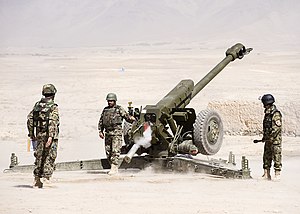| 122 mm howitzer 2A18 (D-30) | |
|---|---|
 D-30A in Afghan service | |
| Type | Howitzer |
| Place of origin | Soviet Union |
| Service history | |
| In service | 1960–present |
| Used by | see Operators |
| Wars |
|
| Production history | |
| Designer | F.F. Petrov |
| Designed | 1950s |
| Manufacturer | PJSC Plant No. 9 |
| Produced | 1960–present |
| Variants | See variants |
| Specifications | |
| Mass | Combat: 3.210 t (3.159 long tons; 3.538 short tons) |
| Length | Transport: 5.4 m (17 ft 9 in) |
| Barrel length | 4.66 m (15 ft 3 in) L/38[9] |
| Width | Transport: 1.9 m (6 ft 3 in) |
| Height | Transport: 1.6 m (5 ft 3 in) |
| Crew | 1+7 |
| Shell | 122 x 447 mm R Separate loading charge and projectile[9] |
| Caliber | 122 mm (4.8 in) |
| Breech | Semi-automatic vertical sliding-wedge[9] |
| Recoil | Hydro-pneumatic |
| Carriage | tripod |
| Elevation | −7° to 70° |
| Traverse | 360° |
| Rate of fire | Maximum: 10–12 rpm Sustained: 5–6 rpm |
| Effective firing range | 15.4 km (9.6 mi) 21.9 km (13.6 mi) (with rocket-assisted projectile) |
The 122-mm howitzer D-30 (GRAU index 2A18) is a Soviet howitzer that first entered service in 1960. It is a robust piece that focuses on the essential features of a towed field gun suitable for all conditions. The D-30 has a maximum range of 15.4 km (9.6 mi) or 21.9 km (13.6 mi) using rocket-assisted projectile ammunition.
With its three-leg mounting, the D-30 can be rapidly traversed through 360 degrees. Although no longer manufactured in the countries of the former Soviet Union, the D-30 is still manufactured internationally and is in service in more than 60 countries' armed forces.
The barrel assembly of the 2A18 gun is used in the 2S1 self-propelled howitzer. There are also Egyptian, Chinese, Serbian, and Syrian self-propelled variants and conversions. The Syrian conversion utilizes the hull of the T-34 tank.
- ^ Francesco Palmas (2012). "Il contenzioso del sahara occidentale fra passato e presente" (PDF). Informazioni della Difesa (in Italian). No. 4. pp. 50–59. Archived (PDF) from the original on 2018-06-12. Retrieved 2018-06-12.
- ^ Cooper, Tom; Fontanellaz, Adrien (October 2016). "La guerre du Kagera". Batailles et Blindés (in French). No. 75. Caraktère. pp. 72–81. ISSN 1765-0828.
- ^ Zaloga, Steven; Luczak, Wojciech; Beldam, Barry (1992). Armor of the Afghanistan War. Armor 2009. Concord Publications. p. 7. ISBN 978-9623619097.
- ^ Cooper, Tom (2013). Great Lakes Conflagration: Second Congo War, 1998 2003. UK: Helion & Company Limited. p. 49. ISBN 978-1-920143-84-8.
- ^ "[Syria] Highway M-20 – Deir ez-Zor. Hunting for "snakes" – Шоссе M-20 – Дейр ез-Зор. Охота на "змей"". YouTube. Archived from the original on 30 December 2017. Retrieved 13 January 2018.
- ^ "Ukrainian Military Deploys Turkish-made Bayraktar Drone in Donbas". Defense World Net. October 26, 2021. Retrieved October 26, 2021.
- ^ شبكة المجد (8 September 2014). "#السلسلة_الوثائقية_الحوثيون–- الجزء الأول". Archived from the original on 14 June 2016. Retrieved 13 January 2018 – via YouTube.
- ^ "YouTube". www.youtube.com. Archived from the original on 17 August 2017. Retrieved 13 January 2018.
- ^ a b c Foss, Christopher (1977). Jane's Pocket Book of Towed Artillery. New York: Collier. p. 93. ISBN 0020806000. OCLC 911907988.